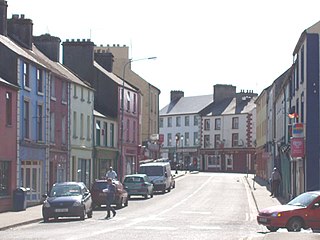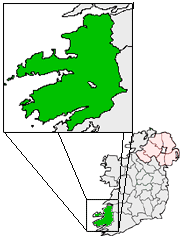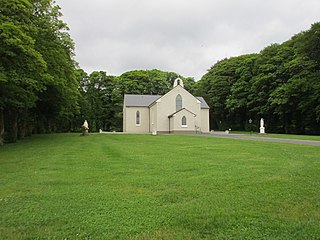Related Research Articles

Ireland is an island in Northern Europe in the north Atlantic Ocean. The island, of up to around 480 km (300 mi) north-south, and 275 km (171 mi) east-west, lies near the western edge of the European continental shelf, part of the Eurasian Plate. Its main geographical features include low central plains surrounded by coastal mountains. The highest peak is Carrauntoohil, which is 1,039 metres (3,409 ft) above sea level. The western coastline is rugged, with many islands, peninsulas, headlands and bays, while the southern and northern coasts feature a smaller number of substantial sea inlets, such as Lough Foyle and Cork Harbour; no part of the land is more than around 110 km (68 mi) from the sea. It was administratively divided into 32 counties, gathered in 4 provinces, though current arrangements, especially in Northern Ireland, differ from this model. The island is almost bisected by the River Shannon, which at 360.5 km (224 mi) with a 102.1 km (63 mi) estuary is the longest river in Ireland and flows south from County Cavan in the province of Ulster to form the boundary between Connacht and Leinster, and later Munster, and meet the Atlantic just south and west of Limerick. There are a number of sizeable lakes along Ireland's rivers, of which Lough Neagh is the largest.
Events from the year 2003 in Ireland.

Slievecallan or Slieve Callan, also historically called 'Mount Callan', is a mountain with a height of 391 metres (1,283 ft) in west County Clare, Ireland. It is the third highest mountain in the county. There is a small lake and two megalithic tombs on the south side, and traditionally the mountain was used for Lughnasa gatherings.

Swinford is a town in County Mayo, Ireland. It is surrounded by a number of smaller villages, including Midfield and Meelick. It is just off the N5 road, 18 km (11 mi) from Ireland West Airport. Situated on a tributary of the River Moy, Swinford is known for its fishing waters, including the Callow lakes and the lakes of Conn and Cullin. Swinford was bypassed in 1993 by the N5 route and was the first town in Mayo to be bypassed.
The primary natural resources of the Republic of Ireland include natural gas, petroleum, peat, copper, lead, dolomite, barite, limestone, gypsum, silver and zinc. Key industries based on these and other natural resources include fishing, mining, and various forms of agriculture and fish farming. The Department of Communications, Energy and Natural Resources is charged with the legislative protection of Ireland's natural resources.
Mannok, formerly the QUINN group, is a business group headquartered in Derrylin, County Fermanagh, Northern Ireland. The group has ventured into cement and concrete products, container glass, general insurance, radiators, plastics, hotels, and real estate. It was formed by Seán Quinn in 1973, developing from a small quarrying operation in Derrylin into a large organization, employing over 8,000 people in various locations throughout Europe.
Fidelma Healy Eames is an Irish former politician. She was first elected to Seanad Éireann in 2007 by the Labour Panel. As a member of the Reform Alliance group, she sat as an Independent senator, having lost the Fine Gael parliamentary party whip in July 2013. In March 2016 she announced her retirement from politics. In April 2019, Healy Eames was a candidate in the 2019 European Parliament election in Ireland for the Midlands-North West constituency.

Ciarán Cannon is an Irish former Fine Gael politician who served as a Teachta Dála (TD) for the Galway East constituency from 2011 to 2024. He previously served as a senator for the Progressive Democrats and was the last elected leader of that party. He served as a Minister of State from 2011 to 2014 and again from 2017 to 2020. He served as a Senator from 2007 to 2011, after being nominated by the Taoiseach.
As of 2021, the island of Ireland had 5,585 MW of installed wind power capacity, with 4,309 MW in the Republic of Ireland. In 2020, wind provided over 86% of Ireland's renewable electricity and generated 36.3% of Ireland's electricity demand, one of the highest percentages globally. In 2023, Wind Energy Ireland confirmed that wind farms provided 35 per cent of Ireland and Northern Ireland’s electricity in 2023, totalling a record breaking 13,725 gigawatt-hours (GWh). Ireland has over 300 wind farms, mostly onshore. A Public Service Obligation subsidy supports renewable energy and wind power development, driven by concerns over energy, security, and climate change mitigation.

The environmental impact of electricity generation from wind power is minor when compared to that of fossil fuel power. Wind turbines have some of the lowest global warming potential per unit of electricity generated: far less greenhouse gas is emitted than for the average unit of electricity, so wind power helps limit climate change. Wind power consumes no fuel, and emits no air pollution, unlike fossil fuel power sources. The energy consumed to manufacture and transport the materials used to build a wind power plant is equal to the new energy produced by the plant within a few months.

The Kerry bog slides natural disaster occurred in the Maghanknockane area of Lyrecrompane, County Kerry, Ireland in August and September 2008. The original bogslide extended over four kilometres on 22 and 23 August destroying an estimated 10 hectares of bog, engulfing two bridges and led to the closure of a section of road; it was reported that it could take anything up to six months to fix the road. The plot of land owned by Moss Moore which inspired John B. Keane's play The Field escaped the disaster by only a couple of kilometres. Comparisons were drawn with the occurrence of an earthquake as it was claimed that a 30-metre (98-foot) wide section was missing from the hill. The event was likened to the 2003 Derrybrien landslide in County Galway.

Derrybrien is a tiny village in County Galway, Ireland. It lies along the R353 road in the Slieve Aughty Mountains. The village church is dedicated to Saint Patrick and is part of the Roman Catholic Parish of Ballinakill and Derrybrien.

Policy makers often debate the constraints and opportunities of renewable energy.

Karin Dubsky is a German-Irish marine ecologist working in Trinity College Dublin, notable as an environmental activist, the coordinator and co-founder of Coastwatch Europe, an environmental NGO and a member of the European Environmental Bureau.
Viking Wind Farm is a large on-shore wind farm in the Shetland Islands which was developed by Viking Energy, a partnership between Shetland Islands Council and SSE plc. It has a generation capacity of 443 MW.

Róisín Garvey is an Irish Green Party politician who served as a Senator from June 2020 to January 2025, after being nominated by the Taoiseach. She was elected deputy leader of the Green Party on 14 July 2024.

Killeenadeema is a civil parish in County Galway, Ireland. It contains most of the Derrybrien mountains, which hold the Derrybrien Wind Farm.
The Burkes are an Irish family from Castlebar, County Mayo, known for their religious activism and frequent involvement in legal cases and protests in Ireland. The family are fundamentalist evangelical Christian Protestants. Family members are parents Sean and Martina Burke and their ten children: Ammi, Elijah, Enoch, Esther, Isaac, Jemima, Josiah, Keren, Kezia, and Simeon. Subjects of their protests include student rights and the LGBT community in Ireland. The family are not known to associate with any Evangelical group in the West of Ireland.
Galway Wind Park is one of Ireland's largest onshore wind farms. Located in Connemara's Cloosh Valley west of Moycullen, County Galway. The wind park was co-developed by SSE Renewables and Coillte at a cost of €280 million and consists of 58 Siemens 3 MW SWT-3.0-101 wind turbines. The wind park provides energy to around 89,000 homes, which is equivalent to 80% of the homes in Galway.
The Derrinlough briquette factory was a briquette manufacturing facility in County Offaly, Ireland, opened in 1957. It ceased production on 26 May 2023.
References
- 1 2 "EU court rules against Ireland on Derrybrien". rte.ie. RTÉ News. 3 July 2008. Retrieved 9 July 2020.
- 1 2 Douglas, Ed (5 July 2006). "The hidden cost of wind turbines". New Scientist. Retrieved 16 June 2020.
- 1 2 Richard Lindsay; Olivia Bragg (2004). Wind farms and blanket peat (PDF) (Report). University of East London. pp. 70, 79–87, 111. Archived from the original (PDF) on 18 December 2013.
- ↑ "Companies convicted for Galway river pollution". rte.ie. RTÉ News. 20 October 2004. Retrieved 9 July 2020.
- ↑ "Galway court dismisses pollution prosecution". rte.ie. RTÉ News. 19 October 2004. Retrieved 9 July 2020.